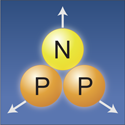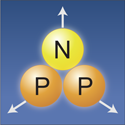Trinucleon physics
Trinucleon physics encompasses the bound state of three nucleons, nucleon-deuteron elastic scattering, and reactions between a nucleon and a deuteron that lead to free nucleons. Calculating the properties of the three-nucleon system is a formidable challenge, and as such plays a key role in developing our understanding of nuclear forces.
Modeling the scattering and reactions between a neutron and a deuteron, where there is no Coulomb potential, is considerably simpler than for the proton-deuteron system. For this reason, even though there are more data for the proton-deuteron system, the corresponding comprehensive calculations above the threshold for breakup into free nucleons are lacking, hindering progress in this field. In a paper appearing in Physical Review C, Arnoldas Deltuva at the Universidade de Lisboa in Portugal remedies this situation.
Deltuva presents, for the first time, a calculation of the elastic scattering of a proton and a deuteron, and the breakup observables, that includes both a realistic three-nucleon force (the phenomenological Urbana UR-IX model, which utilizes parameters constrained by nuclear matter calculations) and the Coulomb interaction between the two protons. The realistic Argonne v18 model is used to describe the nucleon-nucleon interactions. Comparison with precision data at two energies illustrates that including the Coulomb interaction can significantly increase or decrease the differential cross section.
A clear signal of three-nucleon force effects can be seen in the spin observables, the result of a complex interplay between the three-nucleon force and the Coulomb interaction. Unfortunately, the low-energy “space star anomaly,” in which the three nucleons emerge separated by equal angles, remains unresolved. – Benjamin Gibson





